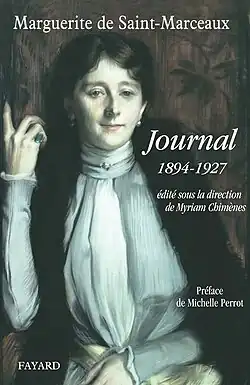Marguerite de Saint-Marceaux
Lucie Frederica Marguerite "Meg" de Paul de Saint-Marceaux (née Jourdain; 9 May 1850 – 23 February 1930), formerly Baugnies, was a French salonnière, arts patron, diarist, and dilettante pianist and opera singer. She was celebrated for her salons, where she hosted intellectual and artistic masters including Marcel Proust, Colette, Giovanni Boldini, Maurice Ravel, Isadora Duncan, and Gabriel Fauré. A number of musical works were debuted at her salons, including excerpts of Claude Debussy's Pelléas et Mélisande and Prélude à l'après-midi d'un faune and Fauré's Mandoline from Cinq mélodies "de Venise". Fauré, who was a close friend of de Saint-Marceaux, dedicated two of his works, Trois mélodies, Op. 7 and Nocturne No. 1 in E♭ minor, Op. 33/1, to her. In 1903, she was hired by Alfred Cortot to sing in the choir for Richard Wagner's Parsifal at the Société des Concerts.
Marguerite de Saint-Marceaux | |
|---|---|
 1882 portrait of Marguerite by Pauline Croizette | |
| Born | Lucie Frederica Marguerite Jourdain 9 May 1850 |
| Died | 23 February 1930 (aged 79) |
| Resting place | Cuy-Saint-Fiacre |
| Occupation(s) | salonnière, singer, pianist, arts patron, diarist |
| Spouse(s) | Eugène Baugnies René de Saint-Marceaux |
| Children | 3 |
Early life
Marguerite de Saint-Marceaux was born Lucie Frederica Marguerite Jourdain on 9 May 1850 in Louviers into a family of prominent drapers.[1] Her father was Frédéric-Joseph Jourdain.[2] She was the half-sister of the painter Roger Joseph Jourdain. De Saint-Marceaux received an extensive musical education from Antoine François Marmontel, François Seghers, and Romain Bussine.[3] She learned to play the piano and sing, and had a "warm and penetrating voice" according to Emmanuel Chabrier.
Marriages

As a young woman, de Saint-Marceaux was courted by the composer Camille Saint-Saëns, who asked for her hand in marriage, but her family demanded she refuse him due to his rather Bohemian situation.
She was introduced to the visual arts scene in the 1860s by her half-brother and, in 1870, she married the painter Eugène Baugnies.[1] She gave birth to three sons with Baugnies: Georges, Jacques, and Jean.[1] In 1875, the architect Jules Février completed the construction of the Baugnies' mansion at 100 Boulevard Malesherbes, near Parc Monceau in the 8th arrondissement of Paris.
Upon the death of her husband, de Saint-Marceaux inherited a large fortune. In 1892, she married the sculptor Charles René de Paul de Saint-Marceaux.[4][1] Her second husband's family were part of the French nobility descended from the Lords of Saint-Marceaux.[5] Her husband's grandfather, Augustin de Saint-Marceaux, served as mayor of Reims.[5] Her husband adopted her three sons, who then took on the surname "Baugnies de Paul de Saint-Marceaux".[2]
Salons and artistic patronages
De Saint-Marceaux became a celebrated salonnière in the 1880s up until the outbreak of World War I, hosting musical and artistic salons at her Malesherbes mansion, where she invited painters, writers, and musicians to mingle with aristocrats and other members of the Parisian upper class.[4][6] Her salons, considered very informal and Bohemian, were on Friday evenings and full evening dress was prohibited.[6] She also hosted Les gens du monde, or fashionable people including politicians and diplomats, at formal dinners on Thursdays.[6] Her salons were frequented by Colette, Henry Gauthier-Villars, Marcel Proust, Alfred Cortot, Jeanne de Montagnac, Maximilian von Jaunez, Florent Schmitt, Henry Février, Jacques Février, André Messager, Giovanni Boldini, Maurice Ravel, Claude Debussy, Reynaldo Hahn, Gabriel Fauré, Georges Clairin, Charles Koechlin, René Billotte, and Jacques-Émile Blanche.[1][7]
Her salons were described in the correspondence and writings of various attendees including Fauré, Ravel, Schmitt, Koechlin, Messager, Hahn, Cortot, Proust, Colette, and Gauthier-Villars.[6]
Colette wrote about de Saint-Marceaux's salons,[1] saying:
"The meetings at the hôtel Saint-Marceaux, more than a social curiosity, were a reward granted to the faithful of music, a kind of lofty recreation, the bastion of artistic intimacy… A dinner, always excellent, preceded these meetings where the hostess maintained an atmosphere of "supervised freedom". She didn't force anyone to listen to the music, but repressed the slightest whisper... No one thought it bad that Monsieur de Saint-Marceaux was absorbed in reading, that the sons of the house retired to the upper floor, that the painters Clairin, Billotte took refuge in a quarrel between painters, whether Gabriel Fauré preferred to music the pleasure of drawing in three strokes of the pen the portrait of long and bearded Koechlin, or that of Henri February, father of Jacques. Sometimes, the phalanx of musicians threw themselves on old music books, played, sang with soul now Loïsa Puget, plundered a repertoire of 1840 haunted by madmen on the moor, Breton brides leaning on the moles, young girls intoxicated by the waltz … Often, side by side on the bench of one of the pianos, Fauré and Messager improvised with four hands, competing in abrupt modulations, out of tune escapes. They both loved this game during which they exchanged duelist apostrophes: "Parry that one! and that one, you were waiting for it? Always go, I'll pinch you again". Fauré, emir bistré, shook his silver crest, smiled at the pitfalls and redoubled them… A parodic quadrille, with four hands, where the leivmotives of the Tetralogy met, often rang the curfew."[8]
De Saint-Marceaux was also fond of writers, particularly playwrights, and invited many to her salons. Frequently in attendance were Édouard Bourdet, Robert de Flers, Abel Hermant, Paul Hervieu, Henri Lavedan, Jules Lemaître, and Victorien Sardou. She also hosted journalists and critics including André Beaunier, Gaston Calmette, Louis Gillet, Adrien Hébrard, Arthur Meyer, and Pierre Lalo.[1]
Art collectors and curators, including Louis Gonse, Jules Maciet, Raymond Kœchlin, Victor Martin Le Roy, Pierre Louis Pujalet and architects like Charles Girault, Alfred Vaudoyer and Georges Vaudoyer also frequented her salons.[1]
In 1901, she hosted Isadora Duncan at a salon, who later performed at de Saint-Marceaux's son Jean's wedding.
Some of her salons were hosted at her country estate in Cuy-Saint-Fiacre, which she inherited from her first husband's parents.[2] Guests of her country salons were required to play tennis, go on daily walks, go horseback riding, and ride bicycles.
Although she reportedly preferred her own salon, de Saint-Marceaux received invitations to salons hosted by the Princess Edmond de Polignac, the Duchess d'Uzès, Countess Martine de Béhague, the Baroness of Pierrebourg, and the Countess of Guerne.
Musical patronages
De Saint-Marceaux was patroness to numerous composers, some affiliated with the Paris Opera, including Isaac Albeniz, Pierre de Bréville, Ernest Chausson, Paul Dukas, Pablo Casals, Manuel de Falla, Vincent d'Indy, Giacomo Puccini, Francis Poulenc, Albert Roussel, Gustave Samazeuilh, Camille Saint-Saëns, Déodat de Séverac.[9][1]
Colette and Ravel met at one of de Saint-Marceaux's salons, wich led to their collaboration on L'enfant et les sortilèges. Ravel, who was a frequent guest of the salon, played private performances of his works for de Saint-Marceaux including Trio avec piano, Ma mère l'Oye, L'heure espagnole, Miroirs, and Sonatine. Ravel also dedicated a segment of his unpublished work Shéhérazade to de Saint-Marceaux.
Debussy and Messager debuted excerpts of the opera Pelléas et Mélisande at one salon. In 1894, Debussy debuted his symphonic poem Prélude à l'après-midi d'un faune at one of her salons.
Fauré dedicated two of his works, Trois mélodies, Op. 7 and Nocturne No. 1 in E♭ minor, Op. 33/1, to de Saint-Marceaux.[10] She introduced Fauré to his future wife, Marie Frémiet, the daughter of sculptor Emmanuel Frémiet, at one of her salons. On 21 June 1891, he premiered Mandoline from Cinq mélodies "de Venise" at her salon.[11]
Alfred Cortot, who introduced de Saint-Marceaux to the music of Richard Wagner, hired her to sing in the choir for Parsifal in 1903.
In 1900, she hired the violinist Jacques Thibaud, a new graduate from the Conservatoire de Paris, to play at one of her salons. She noted the experience in her diary, writing:
"Thibaud with his quartet plays at my house the 2nd quartet of Fauré and that of Saint-Saëns, and also the piano and violin sonata [by Fauré]. Exquisite evening. It costs me 200 francs, it is worth 1000."
Artistic patronages
Having been introduced to the world of visual arts by her half-brother, de Saint-Marceaux remained a patroness of painters and sculptors alike after the death of her first husband, and visual artists frequented her salon. She was known to financially support artists and attended their exhibitions. These artists included Jacques-Émile Blanche, Giovanni Boldini, Carolus-Duran, Georges Clairin, Édouard Detaille, Guillaume Dubufe, Henri Gervex, Paul Landowski, Paul Mathey, Madeleine Lemaire, Antonin Mercié, and François Pompon.
Through her artistic connections, she was introduced to Claude Monet, who received her at his home in Giverny.[2]
Later life and death

De Saint-Marceaux kept a diary, until 1927, where she documented her experiences in Parisian society.[12]
She died on 23 February 1930 in the 17th arrondissement of Paris.
References
- "Journal, 1894-1927, de Marguerite de Saint-Marceaux : avis et résumé critique de Kingsale". www.gregoiredetours.fr.
- "Item – Articles en ligne".
- Marguerite de Saint-Marceaux ( pref. Michelle Perrot ), Journal: 1894-1927: edited under the direction of Myriam Chimènes , Paris, Arthème Fayard ,2007, 1488 p. ( ISBN 978-2-213-62523-2 ).
- "Saint-Marceaux, René de – Haggin Museum". hagginmuseum.org.
- "Green de Saint Marsault". man8rove.com.
- ""Courtly and polite, mixed with humor and sarcasm": Florent Schmitt sits for an interview with Le Guide du concert magazine (1929)". Florent Schmitt. February 14, 2023.
- "Catalogue | The Catalogue | Jaunez, Madame Maximilian von, née Jeanne de Montagnac; other married name comtesse Charles de Polignac | The de Laszlo Archive Trust". www.delaszlocatalogueraisonne.com.
- Colette, Journal à rebours , Paris, Fayard ,1984, 215 p. ( ISBN 2-213-01455-8 )
- Jean-Michel Nectoux, Antoinette Le Normand-Romain and Michel Delahaye, A family of artists in 1900: the Saint-Marceaux, Paris, RMN,1992, 108 p. ( ISBN 2-7118-2726-7 )
- Nectoux, Jean-Michel (1991). Gabriel Fauré – A Musical Life. Roger Nichols (trans). pg. 34. Cambridge: Cambridge University Press. ISBN 0-521-23524-3.
- Nectoux, Jean-Michel (2004). Gabriel Fauré: A Musical Life. Cambridge: Cambridge University Press. ISBN 0-521-61695-6.
- Saint-Marceaux, Marguerite de; Chimènes, Myriam (July 11, 2007). "Journal: 1894-1927". Fayard – via Google Books.